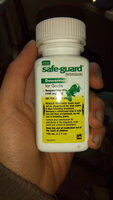noisegeyser
Songster
- Mar 28, 2019
- 90
- 76
- 111
I know there is already a thread about Fenbendazole, but I thought I should make a thread about this particular product as I'm seeing conflicting reports of how much to use and in what fashion. In the "worming with Fenbendazole" thread, I saw one user had used a 2.25ml dosage of the stuff for every gallon of water, stirring occasionally so it wouldn't settle (what I have decided to do). On the other hand, I've asked about this product on another website and I was told the following:
"Yes, you can use that. It's just 10% fenbendazole. Dose at ~50mg/kg. Weigh your birds. Since that's a suspension, you can use ml instead of weighing. Give 50ml per kg of weight. So if your bird is half a kg, give 25ml."
Since he's talking about administering it orally I had imagined the doses would be different, but in the tens of milliliters? That just didn't sound right to me, and I'm having a hard time finding information on it's use with poultry. Obviously I don't want to hurt my birds by using too much, or not dealing with the problem by using too little. But I'm kind going in blind here. What do you guys think?
What I'm using:
https://www.amazon.com/dp/B000HHLVB8/?tag=backy-20
"Yes, you can use that. It's just 10% fenbendazole. Dose at ~50mg/kg. Weigh your birds. Since that's a suspension, you can use ml instead of weighing. Give 50ml per kg of weight. So if your bird is half a kg, give 25ml."
Since he's talking about administering it orally I had imagined the doses would be different, but in the tens of milliliters? That just didn't sound right to me, and I'm having a hard time finding information on it's use with poultry. Obviously I don't want to hurt my birds by using too much, or not dealing with the problem by using too little. But I'm kind going in blind here. What do you guys think?
What I'm using:
https://www.amazon.com/dp/B000HHLVB8/?tag=backy-20







